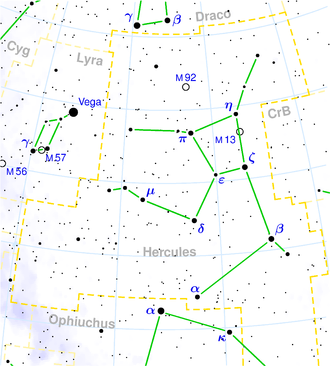NGC 6078
| Galaxie NGC 6078 | |
|---|---|
![NGC 6078 mit PGC 57459 (u)[1] SDSS-Aufnahme](http://upload.wikimedia.org/wikipedia/commons/thumb/7/7e/NGC6078_-_SDSS_DR14.jpg/300px-NGC6078_-_SDSS_DR14.jpg) | |
| NGC 6078 mit PGC 57459 (u)[1] SDSS-Aufnahme | |
| AladinLite | |
| Sternbild | Herkules |
| Position Äquinoktium: J2000.0, Epoche: J2000.0 | |
| Rektaszension | 16h 12m 05,4s[2] |
| Deklination | +14° 12′ 32″ [2] |
| Erscheinungsbild | |
| Morphologischer Typ | E [2] |
| Helligkeit (visuell) | 15,2 mag [3] |
| Helligkeit (B-Band) | 16,2 mag [3] |
| Winkelausdehnung | 0,5′ × 0,5′ [3] |
| Flächenhelligkeit | 13,8 mag/arcmin² [3] |
| Physikalische Daten | |
| Rotverschiebung | 0,031282 ± 0,000147 [2] |
| Radialgeschwindigkeit | (9378 ± 44) km/s [2] |
| Hubbledistanz vrad / H0 | (423 ± 30) · 106 Lj (129,7 ± 9,1) Mpc [2] |
| Geschichte | |
| Entdeckung | Édouard Stephan |
| Entdeckungsdatum | 21. Juni 1876 |
| Katalogbezeichnungen | |
| NGC 6078 • PGC 57460 • CGCG 079-076 • MCG +02-41-017 • 2MASX J16120546+1412317 • GC 5807 • GALEXASC J161205.42+141231.3 • LDCE 1180 NED002 | |
NGC 6078 ist eine 15,2 mag helle Elliptische Galaxie vom Hubble-Typ E0 im Sternbild Herkules am Nordsternhimmel. Sie ist schätzungsweise 423 Millionen Lichtjahre von der Milchstraße entfernt und hat einen Durchmesser von etwa 65.000 Lichtjahren.
Im selben Himmelsareal befinden sich u. a. die Galaxien NGC 6074 und NGC 6083.
Die Typ-Ia-Supernova SN 2011dv wurde hier beobachtet.[4]
Das Objekt wurde am 21. Juni 1876 von Édouard Stephan entdeckt.[5]
Einzelnachweise
Weblinks
- NGC 6078. DSO Browser, abgerufen am 29. Mai 2016 (englisch).
- NGC 6078. SIMBAD, abgerufen am 29. Mai 2016 (englisch).
- Auke Slotegraaf: NGC 6078. Deep Sky Observer's Companion, abgerufen am 29. Mai 2016 (englisch).
Auf dieser Seite verwendete Medien
Autor/Urheber: Sloan Digital Sky Survey, Lizenz: CC BY 4.0
The sky image is obtained by Sloan Digital Sky Survey, DR14 with SciServer.
Angle of view: 4' × 4' (0.3" per pixel), north is up.
Details on the image processing pipeline: https://www.sdss.org/dr14/imaging/jpg-images-on-skyserver/



